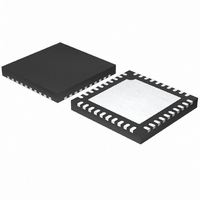MAX15035ETL+ Maxim Integrated Products, MAX15035ETL+ Datasheet - Page 15

MAX15035ETL+
Manufacturer Part Number
MAX15035ETL+
Description
IC REG STEP DOWN 15A 40-TQFN
Manufacturer
Maxim Integrated Products
Type
Step-Down (Buck)r
Datasheet
1.MAX15035ETL.pdf
(26 pages)
Specifications of MAX15035ETL+
Internal Switch(s)
Yes
Synchronous Rectifier
Yes
Number Of Outputs
1
Voltage - Output
1.05V, 1.5V
Current - Output
15A
Voltage - Input
4.5 ~ 26 V
Operating Temperature
-40°C ~ 85°C
Mounting Type
Surface Mount
Package / Case
40-TQFN Exposed Pad
Power - Output
2.16W
Lead Free Status / RoHS Status
Lead free / RoHS Compliant
Frequency - Switching
-
Lead Free Status / Rohs Status
Lead free / RoHS Compliant
Power-on reset (POR) occurs when V
approximately 3V, resetting the fault latch and prepar-
ing the controller for operation. The V
inhibits switching until V
troller powers up the reference once the system
enables the controller, V
driven high. With the reference in regulation, the con-
troller ramps the output voltage to the target REFIN volt-
age with a 1.2mV/μs slew rate:
The soft-start circuitry does not use a variable current
limit, so full output current is available immediately.
PGOOD becomes high impedance approximately
200μs after the target REFIN voltage has been reached.
The MAX15035 automatically uses pulse-skipping mode
during soft-start and uses forced-PWM mode during
soft-shutdown, regardless of the SKIP configuration.
For automatic startup, the input voltage should be pre-
sent before V
output into regulation without the input voltage present,
the fault latch trips. The controller remains shut down
until the fault latch is cleared by toggling EN or cycling
the V
If the V
assumes that there is not enough supply voltage to
make valid decisions. To protect the output from over-
voltage faults, the controller shuts down immediately
and forces a high impedance on LX.
When the system pulls EN low, the MAX15035 enters
low-power shutdown mode. PGOOD is pulled low
immediately, and the output voltage ramps down with a
1.2mV/μs slew rate:
Slowly discharging the output capacitors by slewing
the output over a long period of time (typically 0.5ms to
2ms) keeps the average negative inductor current low
(damped response), thereby preventing the negative
output-voltage excursion that occurs when the con-
troller discharges the output quickly by permanently
turning on the low-side MOSFET (underdamped
response). This eliminates the need for the Schottky
diode normally connected between the output and
ground to clamp the negative output-voltage excursion.
After the controller reaches the zero target, the
MAX15035 shuts down completely—the drivers are dis-
abled (high impedance on LX)—the reference turns off,
and the supply currents drop to about 0.1μA (typ).
15A Step-Down Regulator with Internal Switches
CC
CC
power supply below 0.5V.
voltage drops below 4.25V, the controller
t
t
START
CC
SHDN
. If the controller attempts to bring the
______________________________________________________________________________________
=
=
1 2
1 2
.
.
CC
CC
V
mV s
V
mV s
FB
FB
rises above 4.25V. The con-
exceeds 4.25V, and EN is
μ
μ
=
=
1 2
1 2
.
.
V
V
CC
V ms
V ms
FB
FB
CC
UVLO circuitry
Shutdown
rises above
When a fault condition—output UVP or thermal shut-
down—activates the shutdown sequence, the protection
circuitry sets the fault latch to prevent the controller from
restarting. To clear the fault latch and reactivate the
controller, toggle EN or cycle V
The MAX15035 automatically uses pulse-skipping mode
during soft-start and uses forced-PWM mode during
soft-shutdown, regardless of the SKIP configuration.
Leaving SKIP unconnected activates a unique pulse-
skipping mode with a minimum switching frequency of
18kHz. This ultrasonic pulse-skipping mode eliminates
audio-frequency modulation that would otherwise be
present when a lightly loaded controller automatically
skips pulses. In ultrasonic mode, the controller automati-
cally transitions to fixed-frequency PWM operation when
the load reaches the same critical conduction point
(I
An ultrasonic pulse occurs when the controller detects
that no switching has occurred within the last 33μs.
Once triggered, the ultrasonic controller turns on the
low-side MOSFET to induce a negative inductor current
(Figure 3). After the inductor current reaches the nega-
tive ultrasonic current threshold, the controller turns off
the low-side MOSFET and triggers a constant on-time.
Figure 3. Ultrasonic Waveform
LOAD(SKIP)
0
I
) that occurs when normally pulse skipping.
SONIC
Ultrasonic Mode ( S S K K I I P P = Open = 3.3V)
33μs (typ)
Modes of Operation
CC
ZERO-CROSSING
ON-TIME (t
DETECTION
power below 0.5V.
ON
)
INDUCTOR
CURRENT
15












